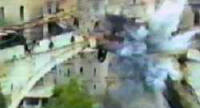Renting a car in Croatia is one of the easiest rental car experiences we've ever had. The concierge at the Bellvue had an arrangement with various rental car companies. The morning we decided to go to Bosnia we went to the concierge and asked if they could get a car for us. As we were having breakfast, we were told the car was waiting outside. We paid a total of about $50 in cash for the day, and that was that. No questions about elective insurance, and that feeling of uneasiness when you opt out, no credit card swipe for incidentals, no nothing.
On the way to Mostar from Dubrovnik, there is a stretch of about 15km that turns from Croatia to Bosnia, then back to Croatia, before entering Bosnia once again (which implies having to wait in line and show your passport before crossing each border). The town of Neum is in this area, and coincidentally, this stretch of land happens to be the only coastal part of Bosnia. The history behind this 15km area is really interesting. In 1399, the Dubrovnik Republic (Ragusa) acquired Neum from Zahumlje. In 1699, Dubrovnik relinquished control of the region to the Ottoman Empire at the Treaty of Karlowitz following the Great Turkish War. It gave the Turkish army access to the sea, and in exchange, the Ottomans agreed to protect Dubrovnik from the Republic of Venice, which was at that time conquering the coastal regions of Croatia. Neum was under Ottoman control for 179 years until 1878, when Bosnia and Herzegovina came under Austro-Hungarian rule. Neum then joined the Kingdom of Serbs, Croats and Slovenes (Yugoslavia) as a part of a number entities between 1919 and 1992 (when Bosnia and Herzegovina declared independence).
 |
| Mostar, Bosnia |
When we finally arrived in Mostar, Alma was already waiting for us. What made Alma an incredibly interesting tour guide is the fact that she is a Bosniak (Muslim) that lived through the war in Bosnia, i.e. she didn't leave like much of the population did. After having just recently heard the perspective of a Croatian soldier, hearing Alma's point of view really provided us with a full picture of the war from two opposing sides. Throughout the tour, Alma told us many of her daily struggles during the war. She lived without electricity or running water for a year and food was rationed as the Bosnian government saw fit. She told us, "you can't tell now, but I ate so little back then, I looked like a super model". For that one year period, she could not go out of her apartment from sun up to sun down for fear of being targeted by snipers that were strategically positioned atop the surrounding mountain range ready to kill. She apparently is working on a book to tell her story, though she already has some notariety being that she appeared in a documentary filmed by Rick Steve's crew in Mostar.
The bridge behind us in the picture below, the Stari Most, is the symbol of Mostar. "Most" means bridge, and the city was named after the people who take care of the bridge. To the people of Mostar, it represents unity and a bridge between different religious and ethnic groups living in Mostar. The bridge was completed under Ottomoan rule in 1566 after nines years of building, amd became a World Heritage site in 2004.
However, it was destroyed by the Croatian army in 1993. As part of our tour, we saw a video of the bridge being destroyed by missiles. I was watching Alma watching the film. Though the bridge has been rebuilt (it took longer to rebuild the bridge, than it originally took to build it) and the city is slowly regaining its strength, I could see the pain in her eyes as she watched the destruction of the bridge. It was as if she was feeling the missiles hitting her heart.
The bridge was originally built using a particular stone from a nearby quarry and was sealed with a red powder, the name of which escapes me. But, when the bridge was missiled, this substance painted the Neretva river below the bridge, red. The people of the town relayed this painful incident as the bridge bleeding to its death.
 |
| The bridge being missiled to destruction in 1993 |
On a lighter note, there is an interesting tradition in Mostar. Historically, the young men of the town, in order to impress the young ladies, would jump from the tip of the arch on the bridge, to the river below. It doesn't seem so high from the picture, but once you get up there, you realize that it takes a great deal of courage to take the leap. Nowadays, because of tourism, the jumpers will do this for money, so before a jump, they collect money from the watching audience. Once they collect their goal, the jumper takes his leap...

No comments:
Post a Comment